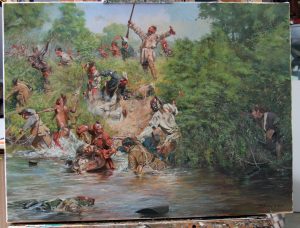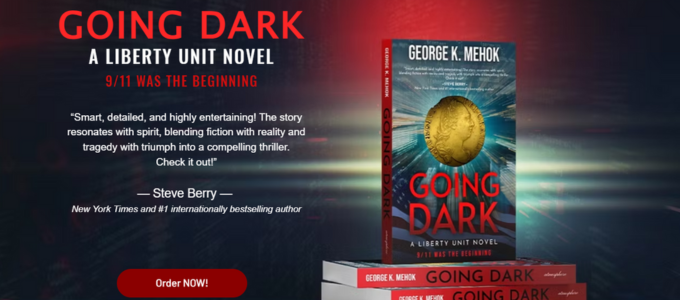
Ask any Civil War or Rev War buff to name one modern day historical artist and chances are Don Troiani will come to mind first. Straight from the bio: “While there are other painters who have turned their attention to historical art, none have done so with the enthusiasm, insight and historical accuracy of this accomplished recorder of drama and detail.” His artwork has appeared on numerous TV shows and in countless publications. He is also one of the top collectors of military artifacts, which he explains is a hobby that enhances his artwork. I asked Don 10 questions recently and learned a great deal about his painting process, obstacles and pipeline. Enjoy!
1 // You are widely respected in history circles for the amount of research behind your artwork. What is your secret to painting with historical accuracy?
No secrets, just the determination to try to get everything as correct as possible. This includes the uniforms, terrain, weather, etc. I also work with many friends who are experts in their own fields who generously add their input.
2 // It seems that you dedicate an equal amount of focus to your artifact collecting. How has collecting Revolutionary War artifacts enhanced your artwork of the period?
There is nothing like having a hands on knowledge of the real item. You know how the item looks on all sides, and the size and weight. Many times weapons in current artwork are painted too small and dainty because the artists have never seen a real one. Often I’ve posed models with original weapons .
3 // If you opened the Don Troiani Museum next week, what three Revolutionary War artifacts from your collection would earn the featured exhibit space?
The regimental coat of Benjamin Holden, Lt. Colonel of Doolittle’s Minute regiment and later the 27th Continental Infantry. There is a good possibility Holden wore this coat when commanding his unit at Bunker/Breed’s Hill. The silver hilted hanger worn by 19 year old Lt. William Falconer of the Grenadier Company of the British 15th Regiment of Foot when he was killed leading his men at the battle of Brandywine. Lastly, a brass cap of the Fusiler Regiment von Kynphausen which was traded to a young militiaman by a Hessian prisoner guarding him after the battle of Trenton.
4 // Which Revolutionary War piece did you have the greatest difficulty painting? Why?
They are all about equally difficult. I’d say ones with specific buildings that have to be recreated are the biggest challenge as it turns me into an architectural artist. Often the backgrounds require a great deal of study as miles of existing terrain may have to be studied to try and get it back to its 18th century appearance.
5 // You have researched and painted numerous Revolutionary War battle scenes. What battle do you most want to travel back in time to witness, and why?
I think the battles around New York in 1776 are very interesting and overlooked since much of it is covered with concrete — out of sight, out of mind, so to speak. Fort Washington and White Plains would be on my list. Fort Washington was the biggest Hessian operation of the war and I like their uniforms a lot. As far as battles of history some of the of the Roman Republic would be exciting to witness.

6 // Have you ever painted yourself or other family/friends into one of your paintings, or used them as inspiration for any of the faces?
I’ve used a few family members in the past that looked the part, my nephew and some inlaws. Some friends as well. I don’t view my work though as opportunity to insert everyone I know for fun, they have to look the part regardless of the relationship to me.
7 // What did serving as a military advisor in the History Channel’s The American Revolution miniseries entail?
It was a lot of work mostly trying to get things right. Film work is different from painting in that you have to convince a large number of people who have their own ideas or don’t care how things should be. You feel like a fire brigade rushing about trying to put out little fires springing up everywhere.
8 // What Revolutionary War scenes are in your painting pipeline?
I want to paint all the major (and some minor) battles of the revolution, North and South. I have a ways to go yet, some Yorktown paintings are on the near horizon. I was down to Yorktown last year studying the terrain and photographing.
9 // How much Bob Ross (of PBS’s The Joy of Painting fame) do you evoke during your painting process? Are you talking to yourself about “happy little trees” or “happy little Loyalists”? What’s your process like?
I never liked those types of shows and didn’t watch them. The process is fun but I wouldn’t describe it as happy, it’s serious work with all sorts of petty problems to agonize over. Once the research is complete and models posed, I make a pencil sketch in detail on the canvas of the whole thing. Then paint it in doing as much of the background as possible and working forward.
10 // I enjoyed observing your artistic process on Facebook with the series of posts you shared about the painting of Ensign Downing’s Escape – Battle of Wyoming. I was amazed to see just how much editing you can do – cutting back trees here, removing a dead body there, etc. Typically, how different is your finished piece from the original concept?
Like a battle plan, once you get to the actual battlefield things can be rather different. With oil paints you can make a lot of changes , however, it’s always better to get it right the first time. Lots of times the thumbnail design sketch doesn’t translate as well in a larger size and you see problems that were no evident previously. Usually the design doesn’t change a whole lot from the sketch, it’s more like adding or removing figures that don’t work well.







Recent Articles
Patrick Ferguson’s Fortification Proposals In South Carolina
Lord Dunmore’s Ethiopian Regiment
A Perfect Frenzy: A Royal Governor, His Black Allies, and the Crisis that Spurred the American Revolution
Recent Comments
"Lord Dunmore’s Ethiopian Regiment"
Thanks for your very interesting article, Andrew. There were also at least...
"Dissecting The Battle of..."
The Painting was apparently stolen [Wikipedia] This painting's whereabouts are unknown as...
"Scott’s Levies: The Virginia..."
John, Some excellent research on a challenging subject. Appreciate your efforts in...